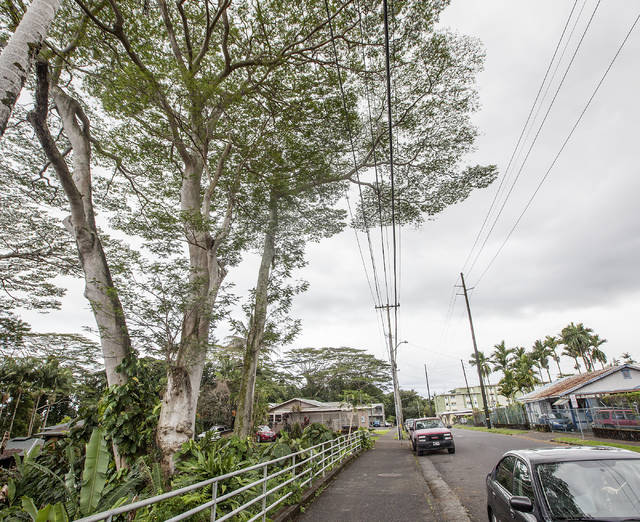Two bills in the state Legislature seek to allow property owners to remove potentially dangerous albizia trees on adjacent properties.
If passed and signed into law, House Bill 213 and Senate Bill 464 would authorize property owners to enter neighboring vacant property and eradicate any threatening albizias there, provided the owners of the adjacent property failed to respond to two or more contacts within 30 days.
Under the auspices of the bills, property owners eradicating neighboring albizias also would be able to cite the bill as a defense against prosecution for trespassing.
The threat of albizias, an invasive species prone to shedding large branches onto surrounding infrastructure, was accentuated during Tropical Storm Iselle in 2014, but has continued to be a concern since, said Springer Kaye, manager of the Big Island Invasive Species Committee.
While the trees can be removed easily enough, problems occur when they grow on the property of a landowner who lives off the island.
“You get absentee landowners who don’t spend much time thinking about their Hawaii property or don’t know about the problem — they don’t understand how having trees on the property might be bad,” Kaye said. “If you have landowners living in another country, it can be hard for their neighbors to contact them; it can be hard for us to contact them.”
The bills would allow concerned landowners to circumvent the current process, which Kaye described as a convoluted and time-consuming loop of failing to contact the offending owners, taking the matter to the county, which also fails to contact them before ultimately paying to remove the trees and putting a lien on the offending property in the hope the property owner will one day be contactable again and pay the county for the tree removal.
However, the bills also will require the concerned landowners to foot the bill for the trees’ removal.
Kaye said trees that overhang streets, sidewalks or other structures require the intervention of an arborist to remove, while those far from other structures or too small to damage anything can be destroyed with a quick application of herbicide.
Rep. Joy San Buenaventura, who introduced HB 213, said the bills have received general support from those who remember the dangers the fallen trees caused during Tropical Storm Iselle.
“These trees fall,” San Buenaventura said. “People remember the number of houses and utilities destroyed and the people trapped during Iselle.”
Only one party who submitted written testimony regarding the bills opposed the proposal: The Hawaii Cattlemen’s Council, whose managing director, Dale Sandlin, expressed concern that ranchers’ pastures might be mistaken for vacant land.
The remainder of the testimony — including statements from Kaye, the state Department of Land and Natural Resources and each of the state’s electric companies — was in support of the bills.
The House bill passed its only committee earlier this month, while the Senate Judiciary committee voted unanimously Tuesday to pass the Senate bill.
Email Michael Brestovansky at mbrestovansky@hawaiitribune-herald.com.

